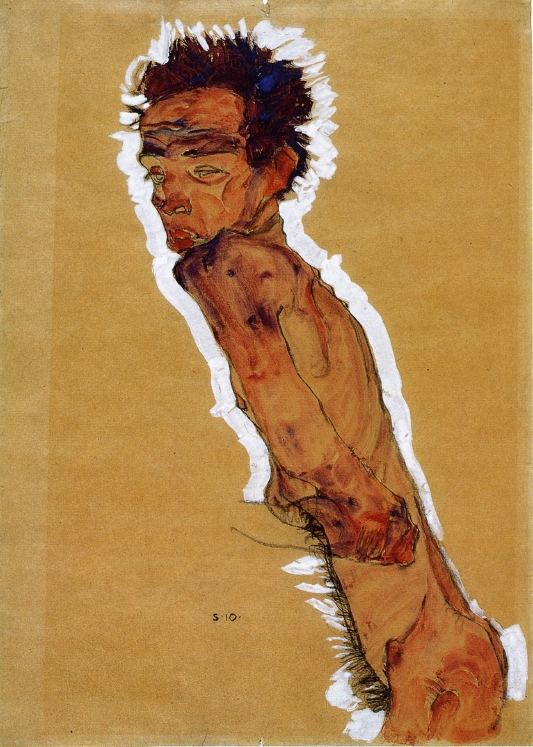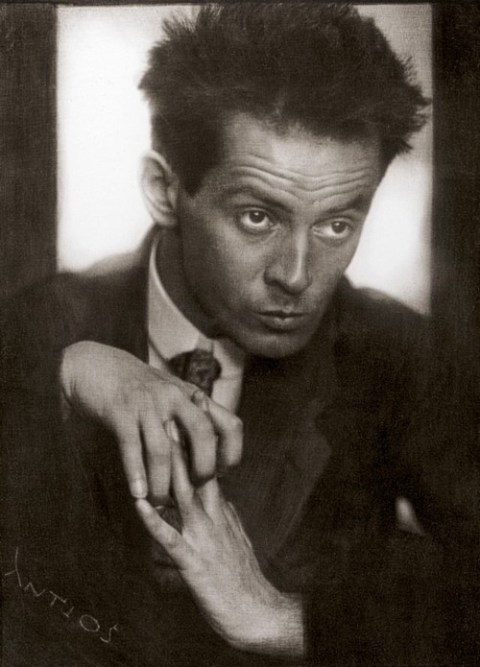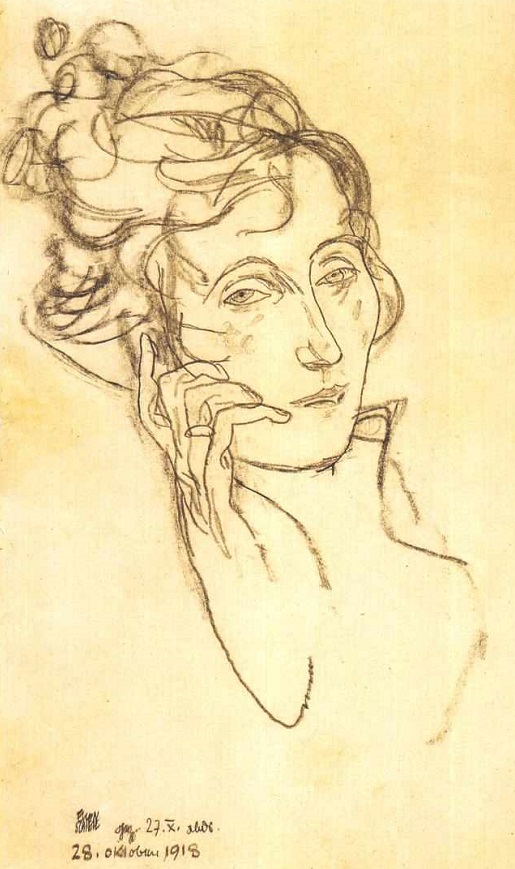Egon Schiele: Ich bin Mensch, ich liebe / Den Tod und Liebe / Das Leben. “I am a Human Being – I love Death and Love – They are alive.”
Posted: October 31, 2013 Filed under: A FEW FAVOURITES / UNA MUESTRA DE FAVORITOS, Egon Schiele, English, German | Tags: German Expressionist poets Comments Off on Egon Schiele: Ich bin Mensch, ich liebe / Den Tod und Liebe / Das Leben. “I am a Human Being – I love Death and Love – They are alive.” ZP_Egon Schiele_Selfportrait_Male nude in profile, facing left_1910
ZP_Egon Schiele_Selfportrait_Male nude in profile, facing left_1910
.
Strange Austrian “wunderkind” Egon Schiele was the son of a railroad station-master in Tulln and a mother from Krumau in Bohemia (Czechoslovakia). Schiele began to draw at the age of 18 months, and was disturbingly precocious when it came to early explorations of his own sexuality. Schiele’s paintings and drawings are always – unmistakably – his, and the artist died on this day (October 31st) in 1918, at the age of 28. One of the many millions who succumbed to the ineptly-named “Spanish Flu” pandemic which began in January 1918 – before the end of what was then known as The Great War – and lasted until December 1920 – Schiele’s art had had, even before the War, so much of Death about it – and yet also of Eros, and of Love. One of the artist’s own poems – and he did write a handful of them to accompany several canvases – states simply: Ich bin Mensch, ich liebe / Den Tod und Liebe / Das Leben. “I am a human being – I love Death and Love – they are alive.” Schiele’s wife Edith, six months pregnant, died of the “Spanish Flu” on October 28th, 1918, and Schiele, himself already extremely ill, made several sketches of her as she lay dying. He was gone just three days later.
.
Translators Will Stone and Anthony Vivis wrote, in an issue of The London Magazine: “In one of his untitled poems Schiele talks of a bird where ‘a thousand greens are reflected in its eyes’. That this was written by an artist of Schiele’s calibre infuses the image with added significance. Who but he could know the shade created by a thousand greens and hold it long enough to record? What matters is not literally that a thousand greens reflect in the bird’s eye, but the possibility that they could. The green of the eye is so overwhelming that in his determination to see truth above all else the precocious poet-artist has glutted himself with a thousand variations within a single colour. While admitting the impossibility of capturing the reality of nature – like a translator faced with a text which appears to defy intra-linguistic interpretation – Schiele takes up the challenge nevertheless. It is a microcosm of the artistic calling: proceeding with creation and conceding defeat at the same moment. The sense of precariousness, the constant wavering of the boundary between lucidity and excruciation, is perhaps why Schiele’s paintings score so deeply into us even today [April 2012].”
.
The Viennese, bourgeois-art-appreciating public had found Schiele’s un-pretty style and colour palette – often there were grey-green hues for skin, as if the living were putrefying – and his candid, awkward-limbed sexuality / unflattering poses / the angst *of his nudes – difficult to look upon. Yet he was really a proto–Expressionist who was leading the way for Expressionism** – that most powerful German artistic movement of the first quarter of the 20th century. Schiele’s influences were Vincent Van Gogh, “Art-Nouveau”, and Gustav Klimt – all from his boyhood – but it’s the poets, not visual artists, of the decade from 1910 forward, that explored – like Schiele was doing – similar discomfiting emotional and psychological “territories”. And so, we have placed a selection of their verses alongside poems of and images of paintings and drawings by Egon Schiele.
.
* Angst is a great-sounding word. It reached German – and English – via the Danish language and an 1844 treatise by the philosopher Kierkegaard. Angst means Existential anxiety or fear.
** German Expressionism – a definition from Ruth J. Owen:
“A Modernist mode, mainly in the second decade of the 20th century; perspective of angst and absurdity; disturbing visions of downfall and decay; pathological world of the crippled and insane, and images of the city and war. ‘Aufbruch’ (an awakening or departure from) becomes ubiquitous – a new era; dislocated colour, shrill tone; the grotesque, deathliness and dissolution.”
. . .
Egon Schiele (1890-1918)
“Ein Selbstbild” / “Self-Portrait” (1910)
.
Ich bin für mich und die, denen
Die durstige Trunksucht nach
Freisein bei mir alles schenkt,
und auch für alle, weil alle
ich auch Liebe, – Liebe
.
Ich bin von vornehmsten
Der Vornehmste
Und von Rückgebern
Der Rückgebigste
.
Ich bin Mensch, ich liebe
Den Tod und Liebe
Das Leben.
. . .
Egon Schiele
“Sensation”
.
High vast winds turned my spine to ice
and I was forced to squint.
On a scratchy wall I saw
the entire world
with all its valleys, mountains and lakes,
with all the animals running around
shadows of trees and the patches of sun
reminded me of clouds.
I strode upon the earth
and had no sense of my limbs
I felt so light.
. . .
“Empfindung”
.
Hohe Grosswinde machten kalt mein Rückgrat
und da schielte ich.
Auf einer krätzigen Mauer sah ich
die ganze Welt
mit allen Tälern und Bergen und Seen,
mit all den Tieren, die da umliefen –
Die Schatten der Bäume und die Sonnenflecken erinnerten
mich an die Wolken.
Auf der Erde schritt ich
und spürte meine Glieder nicht,
so leicht war mir.
. . .
Egon Schiele
“Music while drowning”
.
In no time the black river yoked all my strength
I saw the lesser waters great
and the soft banks steep and high.
.
Twisting I fought
and heard the waters within me,
the fine, beautiful black waters –
then I breathed golden strength once more.
The river ran rigid and more strongly.
. . .
“Musik beim ertrinken”
.
In Momenten jochte der schwarze Fluss meine ganzen Kräfte.
Ich sah die kleinen Wasser gross
Und die sanften Ufer steil und hoch.
.
Drehend rang ich
und hörte die Wasser in mir,
die guten, schönen Shwarzwasser –
Dann atmete ich wieder goldene Kraft.
Der Strom strömte starr und stärker.
.
Egon Schiele’s poems: translations from the German © Will Stone and Anthony Vivis
. . .
Else Lasker-Schüler (1869-1945)
“Oh, let me leave this world”
.
Then you will cry for me.
Copper beeches pour fire
On my warlike dreams.
Through dark underbrush
I crawl,
Through ditches and water.
Wild breakers beat
My heart incessantly;
The enemy within.
Oh let me leave this world!
But even from far away
I’d wander – a flickering light –
Around God’s grave.
. . .
“O ich möcht aus der Welt”
.
Dann weinst du um mich.
Blutbuchen schüren
Meine Träume kriegerisch.
Durch finster Gestrüpp
Muß ich
Und Gräben und Wasser.
Immer schlägt wilde Welle
An mein Herz;
Innerer Feind.
O ich möchte aus der Welt!
Aber auch fern von ihr
Irr ich, ein Flackerlicht
Um Gottes Grab.
. . .
. . .
|
Gottfried Benn (1886-1956) D-Zug Braun wie Kognak. Braun wie Laub. Rotbraun. Malaiengelb. |
Gottfried Benn Express Train Brown as cognac. Brown as leaves. Red-brown. Malayan yellow. . (1912) Translation from the German © Michael Hamburger |
|
Gottfried Benn Vor Einem Kornfeld Vor einem Kornfeld sagte einer: |
Gottfried Benn Before a Cornfield Before a cornfield he said: . (1913) Translation from the German © SuperVert |
.
Georg Heym (1887-1912)
“Umbra vitae”
.
Die Menschen stehen vorwärts in den Straßen
Und sehen auf die großen Himmelszeichen,
Wo die Kometen mit den Feuernasen
Um die gezackten Türme drohend schleichen.
Und alle Dächer sind voll Sternedeuter,
Die in den Himmel stecken große Röhren.
Und Zaubrer, wachsend aus den Bodenlöchern,
In Dunkel schräg, die einen Stern beschwören.
Krankheit und Mißwachs durch die Tore kriechen
In schwarzen Tüchern. Und die Betten tragen
Das Wälzen und das Jammern vieler Siechen,
und welche rennen mit den Totenschragen.
Selbstmörder gehen nachts in großen Horden,
Die suchen vor sich ihr verlornes Wesen,
Gebückt in Süd und West, und Ost und Norden,
Den Staub zerfegend mit den Armen-Besen.
Sie sind wie Staub, der hält noch eine Weile,
Die Haare fallen schon auf ihren Wegen,
Sie springen, daß sie sterben, nun in Eile,
Und sind mit totem Haupt im Feld gelegen.
Noch manchmal zappelnd. Und der Felder Tiere
Stehn um sie blind, und stoßen mit dem Horne
In ihren Bauch. Sie strecken alle viere
Begraben unter Salbei und dem Dorne.
Das Jahr ist tot und leer von seinen Winden,
Das wie ein Mantel hängt voll Wassertriefen,
Und ewig Wetter, die sich klagend winden
Aus Tiefen wolkig wieder zu den Tiefen.
Die Meere aber stocken. In den Wogen
Die Schiffe hängen modernd und verdrossen,
Zerstreut, und keine Strömung wird gezogen
Und aller Himmel Höfe sind verschlossen.
Die Bäume wechseln nicht die Zeiten
Und bleiben ewig tot in ihrem Ende
Und über die verfallnen Wege spreiten
Sie hölzern ihre langen Finger-Hände.
Wer stirbt, der setzt sich auf, sich zu erheben,
Und eben hat er noch ein Wort gesprochen.
Auf einmal ist er fort. Wo ist sein Leben?
Und seine Augen sind wie Glas zerbrochen.
Schatten sind viele. Trübe und verborgen.
Und Träume, die an stummen Türen schleifen,
Und der erwacht, bedrückt von andern Morgen,
Muß schweren Schlaf von grauen Lidern streifen.
. . .
Georg Heym
“Umbra vitae” (The Shadow of Life)
.
The people stand forward in the streets
They stare at the great signs in the heavens
Where comets with their fiery trails
Creep threateningly about the serrated towers.
And all the roofs are filled with stargazers
Sticking their great tubes into the skies
And magicians springing up from the earthworks
Tilting in the darkness, conjuring the one star.
Sickness and perversion creep through the gates
In black gowns. And the beds bear
The tossing and the moans of much wasting
They run with the buckling of death.
The suicides go in great nocturnal hordes
They search before themselves for their lost essence
Bent over in the South and West and the East and North
They dust using their arms as brooms.
They are like dust, holding out for a while
The hair falling out as they move on their way,
They leap, conscious of death, now in haste,
And are buried head-first in the field.
Yet occasionally they twitch still. The animals of the field
Blindly stand around them, poking with their horn
In the stomach. They lie on all fours
Buried under sage and thorn.
The year is dead and emptied of its winds
That hang like a coat covered with drops of water
And eternal weather, which bemoaning turns
From cloudy depth again to the depths.
But the seas stagnate. The ships hang
Rotting and querulous in the waves,
Scattered, no current draws them
And the courts of all heavens are sealed.
The trees fail in their seasonal change
Locked in their deadly finality
And over the decaying path they spread
Their wooden long-fingered hands.
He who dies undertakes to rise again,
Indeed he just spoke a word.
And suddenly he is gone. Where is his life?
And his eyes are like shattered glass.
Many are shadows. Grim and hidden.
And dreams which slip by mute doors,
And who awaken, depressed by other mornings,
Must wipe heavy sleep from greyed lids.
.
(1912)
.
Heym translation © Scott Horton
. . . . .
 ZP_Egon Schiele_photographed at the age of 24 by Anton Josef Trcka_1914
ZP_Egon Schiele_photographed at the age of 24 by Anton Josef Trcka_1914
.
Images (paintings and drawings) featured here:
Egon Schiele_Selfportrait_Male nude in profile, facing left_1910
Egon Schiele_Selfportrait with arm twisted above head_1910
Egon Schiele_Reclining male nude_1911
Egon Schiele_Composition with three male figures_Selfportrait_1911
Egon Schiele_Male nude with a red loincloth_1914
Egon Schiele_Sitzender weiblicher Akt_Female nude sitting_1914
Egon Schiele_Death and the Maiden_1915
Egon Schiele_Sitzende frau mit hochgezogenem knie_The model was – possibly – Wally Neuzil (1894 – 1917). Neuzil was a former model for Gustav Klimt and she became Schiele’s model / muse / lover before his marriage to Edith Harms.
Egon Schiele_Reclining woman with green stockings_Adele Harms_1917
Egon Schiele_Embrace_Lovers II_1917
Egon Schiele_Edith sterbend_Edith dying_October 28th 1918_the last drawing by Schiele
. . . . .









